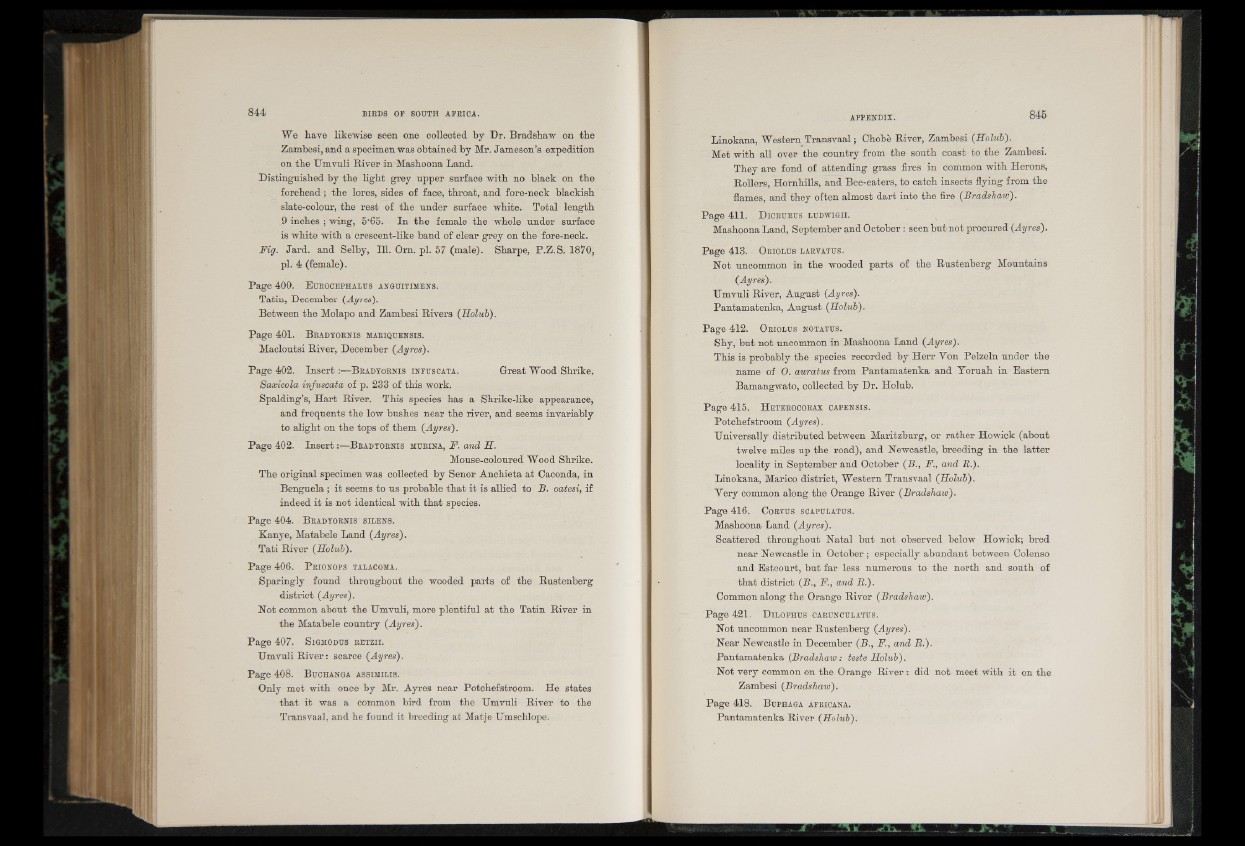
We have likewise seen one collected by Dr. Bradshaw on the
Zambesi, and a specimen was obtained by Mr. Jameson’s expedition
on the TJmvnli River in Mashoona Land.
Distinguished by the light grey upper surface with no black on the
forehead; the lores, sides of face, throat, and fore-neck blackish
slate-colour, the rest of the under surface white. Total length
9 inches ; wing, 5'65. In the female the whole under surface
is white with a crescent-like band of clear grey on the fore-neck.
Fig. Jard. and Selby, 111. Orn. pi. 57 (male). Sharpe, P.Z.S. 1870,
pi. 4 (female).
Page 4 0 0 . E u r o c e p h a lu s a n g u itim e n s .
Tatin, December (Ayres).
Between the Molapo and Zambesi Rivers (Holub).
Page 401. B r a d y o r n i s m a riq u e n s is .
Macloutsi River, December (Ayres).
Page 402. In s e r t:—B r a d y o r n is in f u s c a t a . Great Wood Shrike.
Saxicola infuscata of p. 233 of this work.
Spalding’s, Hart River. This species has a Shrike-like appearance,
and frequents the low bushes near the river, and seems invariably
to alight on the tops of them (Ayres).
Page 402. In s e r t:—B r a d y o r n is m u rin a , F. and H.
Mouse-coloured Wood Shrike.
The original specimen was collected by Senor Anchieta a t Caconda, in
Benguela ; it seems to us probable th a t it is allied to B. oatesi, if
indeed it is not identical with that species.
Page 404. B r a d y o r n is s i l e n s .
Kanye, Matabele Land (Ayres).
Tati River (Holub).
Page 4 0 6 . P r io n o p s ta la c om a .
Sparingly found throughout the wooded parts of the Rustenberg
district (Ayres).
Not common about the TTmvuli, more plentiful a t the Tatin River in
the Matabele country (Ayres).
Page 407. Sigmodus r e t z i i .
Umvuli River: scarce (Ayres).
Page 408. B u c h a n g a a s s im ilis .
Only met with once by Mr. Ayres near Potchefstroom. He states
tha t it was a common bird from the Umvuli River to the
Transvaal, and he found it breeding at Matje Umschlope.
LinnVflna., Western Transvaal; Chobe River, Zambesi (Holub).
Met with all over the country from the south coast to the Zambesi.
They are fond of attending grass fires in common with Herons,
Rollers, Hornhills, and Bee-eaters, to catch insects flying from the
flames, and they often almost d a rt into the fire (Bradshaw).
Page 411. D i c r u r u s lu dw ig ii.
Mashoona Land, September and October: seen but not procured (Ayres).
Page 413. O r io lu s l a r v a t u s .
Not uncommon in the wooded parts of the Rustenberg Mountains
(Ayres).
Umvuli River, August (Ayres).
Pantamatenka, August (Holub).
Page 412. O r io lu s n o t a tu s .
Shy, but not uncommon in Mashoona Land (Ayres).
This is probably the species recorded by Herr Yon Pelzeln under the
name of O. auratus from Pantamatenka and Yoruah in Eastern
Bamangwato, collected by Dr. Holub.
Page 415. H e t e r o c o r a x c a p e n s is .
Potchefstroom (Ayres).
Universally distributed between Maritzburg, or rather Howick (about
twelve miles up the road), and Newcastle, breeding in the la tte r
locality in September and October (B., F., and B.).
Linokana, Marico district, Western Transvaal (Holub).
Very common along the Orange River (Bradshaw).
Page 416. C o rv u s s c a p u la tu s .
Mashoona Land (Ayres).
Scattered throughout Natal but not observed below Howick; bred
near Newcastle in October; especially abundant between Colenso
and Estcourt, but far less numerous to the north and south of
th a t district (B., F., and JR.).
Common along the Orange River (Bradshaw).
Page 421. D ilo p h u s c a r u n c u la tu s .
Not uncommon near Rustenberg (Ayres).
Near Newcastle in December (B., F., and JR.).
Pantamatenka (Bradshaw: teste Holub).
Not very common on the Orange River : did not meet with it on the
Zambesi (Bradshaw).
Page 418. B u p h a g a a f r i c a n a .
Pantamatenka River (Holub).